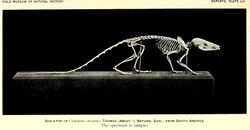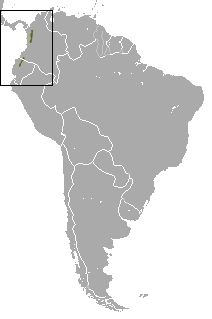Biology:Northern caenolestid
| Northern caenolestid | |
|---|---|

| |
| Skeleton, Field Museum | |
| Scientific classification | |
| Domain: | Eukaryota |
| Kingdom: | Animalia |
| Phylum: | Chordata |
| Class: | Mammalia |
| Infraclass: | Marsupialia |
| Order: | Paucituberculata |
| Family: | Caenolestidae |
| Genus: | Caenolestes |
| Species: | C. convelatus
|
| Binomial name | |
| Caenolestes convelatus Anthony, 1924
| |
| Subspecies | |
| |

| |
| Range of the northern caenolestid | |
The northern caenolestid (Caenolestes convelatus), also known as the blackish shrew opossum, is a shrew opossum found in Colombia and Ecuador. It is listed as Vulnerable by the IUCN.
Taxonomy and etymology
The northern caenolestid is one of the five members of Caenolestes, and is placed in the family Caenolestidae (shrew opossums). It was first described by American zoologist Harold Elmer Anthony in 1924.[2] In the latter part of 20th century, scientists believed that Caenolestes is closely related to Lestoros (the Incan caenolestid).[3][4] Over the years, it became clear that Lestoros is morphologically different from Caenolestes.[5] A 2013 morphological and mitochondrial DNA-based phylogenetic study showed that the Incan caenolestid and the long-nosed caenolestid (Rhyncholestes raphanurus) form a clade sister to Caenolestes. The cladogram below is based on this study.[6]
| |||||||||||||||||||||||||||||||||||||||||||||||||
Two subspecies are recognized:[5]
- C. c. barbarensis H. E. Anthony, 1924: Occurs in western Colombia
- C. c. convelatus Bublitz, 1987: Occurs in northwestern Ecuador
Caenolestid fossils date to as early as the early Eocene (nearly 55 mya). The generic name Caenolestes derives from the Greek words kainos ("new") and lestes ("robber", "pirate").[7]
Description
The northern caenolestid is similar to the gray-bellied caenolestid in coat coloration but differs in cranial features.[8] Kirsch and Waller (1979) gave the following measurements for 1 adult male captured in Colombia in 1969:[9]
- Total length (mm) : 222
- Tail length (mm) : 114
- Hindfoot (mm) : 18
- Ear length (mm) : 14
- Weight (grams) : 25.0
Distribution and habitat
The northern caenolestid occurs in and around alpine and secondary forests. The populations appear to have been divided into two parts – the Andes of western Colombia and northcentral Ecuador. It occurs in an altitudinal range of 1,800 to 3,800 metres (5,900 to 12,500 ft) in Colombia, though in Ecuador it has been recorded at a height of 4,100 metres (13,500 ft). In 2008, the IUCN classified the northern caenolestid as Vulnerable because it is known only from an area of 20,000 square kilometres (7,700 sq mi). Deforestation is a major threat, and more severe in Ecuador.[1]
References
- ↑ 1.0 1.1 Martin, G.M. (2016). "Caenolestes convelatus". IUCN Red List of Threatened Species 2016: e.T40522A22179860. doi:10.2305/IUCN.UK.2016-2.RLTS.T40522A22179860.en. https://www.iucnredlist.org/species/40522/22179860. Retrieved 16 November 2021.
- ↑ Template:MSW3 Paucituberculata
- ↑ Simpson, G.G. (1970). "The Argyrolagidae, extinct South American marsupials". Bulletin of the Museum of Comparative Zoology 139: 1–86.
- ↑ Marshall, L.G. (1980). "Systematics of the South American marsupial family Caenolestidae". Fieldiana: Geology. New Series 5: 1–145.
- ↑ 5.0 5.1 Gardner, A.L., ed (2007). Mammals of South America. 1. Chicago, US: University of Chicago Press. pp. 121; 124–6. ISBN 978-0-226-28242-8. https://books.google.com/books?id=dbU3d7EUCm8C&pg=PA121.
- ↑ Ojala-Barbour, R.; Pinto, C.M.; Brito M., J.; Albuja V., L.; Lee, T.E.; Patterson, B.D. (2013). "A new species of shrew-opossum (Paucituberculata: Caenolestidae) with a phylogeny of extant caenolestids". Journal of Mammalogy 94 (5): 967–82. doi:10.1644/13-MAMM-A-018.1.
- ↑ Patterson, B.D.; Gallardo, M.H. (1987). "Rhyncolestes raphanurus". Mammalian Species (286): 1–5. doi:10.2307/3503866. http://www.science.smith.edu/msi/pdf/i0076-3519-286-01-0001.pdf.
- ↑ Lunde, D.P.; Pacheco, V. (2003). "Shrew opossums (Paucituberculata: Caenolestes) from the Huancabamba region of east Andean Peru". Mammal Study 28 (2): 145–8. doi:10.3106/mammalstudy.28.145. https://www.researchgate.net/publication/242218716.
- ↑ Kirsch, J. A.; Waller, P. F. (1979). "Notes on the Trapping and Behavior of the Caenolestidae (Marsupialia)". Journal of Mammalogy 60 (2): 390–395. doi:10.2307/1379811. https://www.jstor.org/stable/1379811. Retrieved 25 January 2023.
External links
Wikidata ☰ Q194409 entry
es:Caenolestes#Caenolestes convelatus
 |


